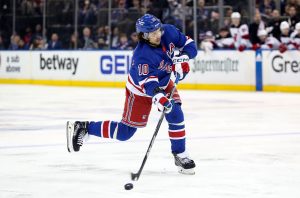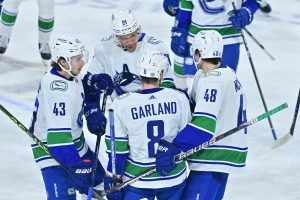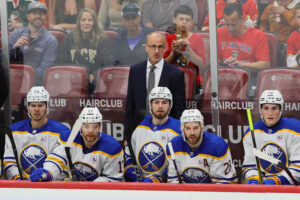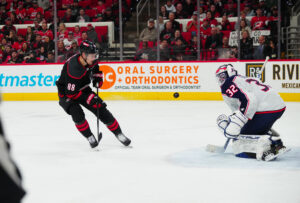The San Jose Sharks weakness comes from an unusually high number of unknowns for this time of year. Compared to the rest of the league, the roster turnover is modest. But compared to recent Sharks seasons, this one is a substantially different.
The changes are largely a result of two things, the Sharks pursuit of high-end talent for last season’s all-in attempt to win a Stanley Cup coupled with a smaller than anticipated salary cap increase. As a result, the Sharks faced a cap crunch and had to move on from several effective players. This is a common issue across the league, but it’s been uncommon for the Sharks. Until now.
Before we dig into the specifics, there’s one point to make clear. The San Jose Sharks are capable of being a Stanley Cup champion this season if they effectively mitigate these issues. If not, they could miss the playoffs. This is a good team, but significantly more vulnerable than recent Sharks teams.
Voids in Sharks Territory
The Sharks still have plenty of top-tier talent, but in the salary cap era, talent comes with a price and as predicted, the Sharks saw a middle class exit this offseason. Four players who played meaningful roles left (and one who played a secondary role also left). As a result, the San Jose Sharks weakness grew.
The most notable departure is Joe Pavelski. This is the first time in a long time that a top-tier player left the Sharks after a highly productive season (others such as Patrick Marleau and Dan Boyle had begun to decline when they left).
Right Wing Void
The most apparent void is at right wing. Three departed players played right wing and they were the team’s three most talented right wingers – Pavelski, Joonas Donskoi and Gustav Nyquist.
The result is a team where two bottom six talents, Kevin Labanc and Melker Karlsson, are now the Sharks best right wingers. They’re also the only two with meaningful NHL experience.
To fill the right wing gap, at least to start the season, the Sharks are relying on unproven talent. Each right winger will play above where they should in an NHL lineup. Talent and experience are issues, so the question becomes this: Will these players have enough chemistry with their more talented linemates to create effective lines? Or will they become the hockey equivalent of a black hole, where offensive pressure goes to die?
Playing Time Void
A less obvious void is playing time. When the Sharks went to the Stanley Cup Final in 2016, they had several players dominate ice time. Among forwards, Joe Thornton, Marleau and Pavelski all played 82 games, averaging a bit over 19 minutes of ice time per game. Only Thornton, now age 40, remains and his ice time will be significantly lower.
Over the years, the Sharks have iced a remarkably durable core. Players averaged big minutes per game while rarely missing a game. Pavelski, Thornton, Braun, Marleau and Brent Burns are among this group, often going multiple seasons without missing a game. Thornton is no longer the durable player he once was while Burns will turn 35 this coming season. The others are gone and a new generation has taken the lead.
The newer generation’s history suggests durability isn’t their strength. Evander Kane and Erik Karlsson are both very talented players. But both players have a history of injury issues. Neither has been healthy during their Sharks playoff runs (Kane twice and Karlsson once). Core players now include Logan Couture, Tomas Hertl and Timo Meier. These are not fragile players, but none have the durability track record of the prior generation.
To fill the void, players like Labanc, Melker Karlsson, Radim Simek and Tim Heed will need to play much bigger roles than perhaps they are suited for. Or the coach will fill the void by increasing ice time for the top-tier players, which carries the risk of wearing them out during the regular season. The Sharks hit a major air pocket in mid-March in two of the last three seasons (losing eight of nine in 2017 and losing nine of 10 in 2019), meaning this late-season history isn’t merely a theoretical concern, but a big, bright, flashing warning sign. Even head coach Peter DeBoer stated his team “ran out of gas.”
Two defencemen are coming off major injuries (Simek and Erik Karlsson). Heed and Labanc are smaller players, whether they can hold up under greater pressure is yet to be determined. Melker Karlsson has a history of injuries limiting him and I’d offer his declining effectiveness in recent seasons is evidence they’ve already taken a toll.
An underappreciated asset of San Jose’s top talent in prior seasons has been their ability to play big minutes and still play nearly every game. The current core of top players doesn’t have the same track record.
Passing the Puck Void
The least obvious void has flown under the radar, but it may be the biggest one of all. The Sharks three best passing forwards (at even strength) last season were Pavelski, Donskoi and Thornton. Since they played a limited amount of time together, the Sharks had an excellent passing forward on the ice for the vast majority of the game. Only Thornton remains, and he’ll likely ring in around the 15 minutes per game he averaged last season. The Sharks forward group has several excellent players, but they are not puck distributors.
The Sharks are driven by power forwards and passing from defencemen. Burns and Erik Karlsson are among the very best in this area. Offense from great passing defencemen is a very good asset, but it isn’t as reliable as an offence capable of generating high-grade scoring chances from close in. Excellent passing forwards are key here. But a lot of them left the building in the off-season.
Sharks Talent Gap
Some teams are equipped to handle player departures because of a quality prospect pipeline. It wasn’t all that long ago when the Sharks were in this spot. The team had too many NHL-level players and not enough spots to go around. The Sharks waived useful low-end players such as Matt Nieto and Ryan Carpenter because the team simply didn’t have roster space.
Times have changed.
There are teams with a robust pipeline of younger, less expensive players capable of playing in the NHL. The San Jose Sharks aren’t among them. My colleague, Ben Kerr covered the Sharks prospects, while a separate column of his ranked them against the rest of the league. The Sharks prospects ranked dead last.
The San Jose Sharks Pipeline
In the past several seasons, the Sharks have danced around the prospect issue by signing European free agents, generally well into their 20’s at the time the Sharks sign them. Consider it an alternative pipeline to the draft. The best of these, Donskoi, left in free agency.
Still, this pipeline is never a sure thing.
Finnish star Antti Suomela was a top Sharks signing last season and there were high hopes for him. Alas he only stayed with the Sharks for the first third of the season and was sent to the AHL for the remainder. His AHL season wasn’t all that impressive, either. But two other newcomers did step up. Lukas Radil proved occasionally useful and Simek was a breakout star in the making, partnering effectively with Burns until a knee injury ended his season.
The Sharks are counting on a handful of players filling roles well above their pay grade. They could use the sort of surprise they received from Simek last season or Donskoi a few seasons earlier. It’d be even more helpful if the surprise came at right wing.
San Jose Sharks Initial Approach
Aside from major injuries, the biggest risks come from the three voids we discussed. Can the Sharks forwards pass effectively? Can the team’s weakness at right wing avoid being a drain on the high-end talent? And can the prospects making the leap be good enough so the top-tier players won’t need to consume the massive minutes which increases the chances of injury or running out of gas later in the season.
The answer to these questions will be an important part of the Sharks 2019-20 story.
Fortunately, the Sharks have an easy and obvious approach to start the season – Put the newer players in big roles. In essence, toss them into the proverbial deep end. Give them plenty of ice time and plenty of opportunity.
The team needs to sort out which players can make the NHL leap this season. Players need full roles, not sheltered minutes. My sense is player chemistry is more critical than talent among those trying to make the leap. Modest talent which works well with others can mitigate a lot of problems. Expect plenty of line juggling. Also expect plenty of players shuffling between the Sharks and their AHL affiliate, the conveniently located San Jose Barracuda.
There are some standing risks here. Too many minutes from ‘not ready for prime time players’ can cost the team points in the standings. That said, this isn’t a season-long experiment, 15-20 games is enough to figure out a lot. Also helpful, the Sharks won’t be the only team figuring things out early on.
Plans B and C
If the San Jose Sharks go through several of their own players and not enough are NHL-capable, the team can execute Plan B. Players like Brian Boyle, Jason Pominville, Thomas Vanek, Eric Fehr and Marleau aren’t ideal, but they are inexpensive and available.
Plan A allows the team’s youth to take their shot. If it fails, Plan B is a reasonable alternative. The key is to figure out if Plan A is the right one in the first quarter of the season. If not, Plan B, signing a veteran (or two) comes into play. If the Sharks aren’t comfortable with the alternatives available at the time, Plan C comes into play. Plan C, the fallback, is an early-season trade.
The Sharks have a primary path scoped out, but this is a vulnerable team. The top-end talent is playoff worthy and good enough to challenge for a Stanley Cup, but the lower end of the roster risks being problematic and could undermine the top players.
For coach DeBoer, the early season challenges are real. How he navigates this will determine if the Sharks need an early course correction.
Zeke’s Notes
Some will wonder if the Sharks pre-season record (their lone win thus far came on Thursday) is concerning. Not at all. The Sharks have put out mostly younger players until the recent win, providing opportunities for growth, coaching and evaluation. This is the right approach.
Main Image Credit:






